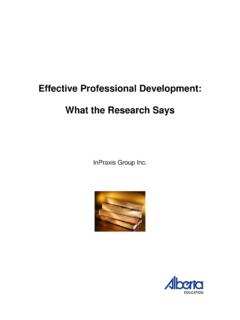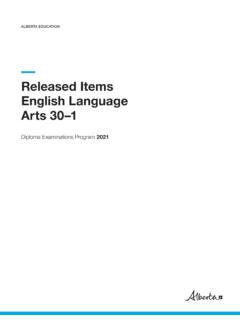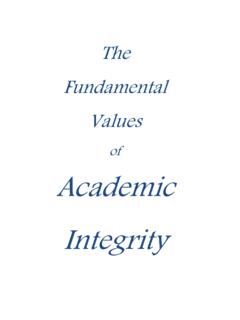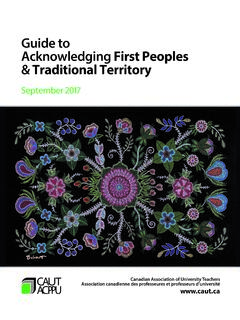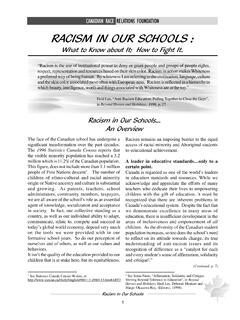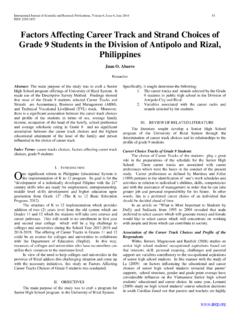Transcription of Special Education Coding Criteria 2021/22 - Alberta
1 MARCH 2021 Classification: Public Special Education Coding Criteria , 2021/22 Early Childhood Services to Grade 12 Mild/Moderate, Gifted and Talented, and Severe 2 Special Education Coding Criteria | ECS to Grade 12 Classification: Public Special Education Coding Criteria , 2021/22 : Early Childhood Services to Grade 12; Mild/Moderate, Gifted and Talented, and Severe Published by Alberta Education , Government of Alberta March 2021 ISBN 978-1-4601-5017-7 (pdf online) ISSN 2368-3627 As part of the Government of Alberta s commitment to open government, this publication is posted to and permanently retained in the Open Government Portal at https This document is intended for.
2 Teachers Administrators Copyright 2021 the Crown in Right of Alberta , as represented by the Minister of Education , Alberta Education , Learner Services Branch, 8th Floor, 10044 108 Street , Edmonton, AB, T5J 5E6. Permission is given by the copyright owner to reproduce this document for educational purposes and on a non-profit basis. Special Education Coding Criteria | ECS to Grade 12 3 Classification: Public Table of Contents Introduction .. 4 Assessment .. 4 Mild/Moderate and Gifted and Talented (ECS to Grade 12) .. 6 Intellectual Disability (Mild).
3 6 Intellectual Disability (Moderate) .. 6 Emotional/Behavioural Disability .. 7 Learning Disability .. 7 Hearing Disability .. 8 Visual Disability .. 8 Communication Disorder/Delay .. 9 Communication Disability/Disorder .. 9 Physical or Medical Disability .. 9 Multiple Disability .. 9 Gifted and Talented .. 10 Severe (ECS to Grade 12) .. 11 Intellectual Disability (Severe) .. 11 Severe Emotional/Behavioural Disability .. 11 Severe Multiple Disability .. 12 Severe Physical or Medical Disability .. 13 Deafness .. 13 Blindness .. 14 Severe Language Delay.
4 14 Moderate Language Delay .. 15 4 Special Education Coding Criteria | ECS to Grade 12 Classification: Public Introduction The Ministerial Order on Student Learning provides an overview of the goals, expectations and outcomes for children and students in Early Childhood Services (ECS) to Grade 12. This framework supports school authorities in determining the amount of additional support required to ensure children and students are successful. All educational programming provided to children and students must be designed and delivered based on the programs of study.
5 The Special Education Coding Criteria , 2021/2 2 outlines Criteria within specific categories to assist teachers and administrators in school authorities to identify those ECS children and Grades 1 12 students who require additional supports in their educational program. Each category is given a code for the purpose of reporting Special Education data to Alberta Education . The need for additional supports may be determined at any time during the school year. It is the responsibility of school authority staff to assign a Special Education code to a child s/student s registration in the Provincial Approach to Student Information (PASI).
6 If assigning more than one Special Education code, one of the codes must be Code 80 (Gifted and Talented). School authorities should work with their PASI administrator to ensure codes are reported accurately in PASI. Schools must have the documentation to support the assignment of a Special Education code. This includes a diagnosis of a disability or disorder by a qualified professional. In addition to this diagnosis, it is essential to have a clear indication of how the disability/disorder impacts the ECS child s and Grade 1 12 student s participation and learning in an educational environment.
7 The Diagnostic and Statistical Manual of Mental Disorders Fifth Edition (DSM-5) has been considered in the updates to the Special Education Coding Criteria , 2020/21; however, this document is not intended to provide diagnostic Criteria for clinicians. Assessment The following information is designed to offer guidance to school authorities regarding Alberta Education s expectations for assessment practices. A qualified professional is an individual who has expertise and training in conducting specialized assessments and providing interpretive reports of the results.
8 The individual is also in good standing with his/her professional association. Psychologists, psychiatrists, audiologists, occupational therapists, and speech language pathologists are some of the qualified professionals who provide assessments and interpretive reports for school authorities. A specialized assessment means individualized measurement across a variety of domains that will contribute to a diagnosis and assist with the development and implementation of an Individualized Program Plan for children and students. Specialized assessments may include administration of tests of intellectual abilities, speech and language abilities, academic performance, emotional and behavioural development, and physical development of a child or student.
9 Specialized assessment typically results in a written, interpretative report. When reviewing reports, the following Criteria applies: the mild range is the 7th to 9th percentile; the moderate range is the 3rd to 6th percentile; and the severe range is the 2nd Special Education Coding Criteria | ECS to Grade 12 5 Classification: Public percentile and below. These ranges correspond to the majority of the tests when a standard score with a mean of 100 and a standard deviation of 15 is reported. A functional assessment includes both formal (objective data such as a standardized checklist) and anecdotal and/or direct observations.
10 The assessment report should provide information about the impact the diagnosis has on the ECS child s/student s functioning in the educational environment in areas such as: social interaction; communication; behaviour; skills for daily living; safety; and other learning considerations. For additional information please refer to the following resources: Standards for the Provision of Early Childhood Special Education ; Standards for Special Education , Amended June 2004; Requirements for Special Education in Accredited Funded Private Schools; Handbook for the Identification and Review of Students with Severe Disabilities; and The Inclusive Education Library.










